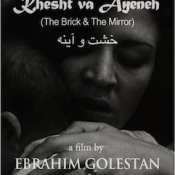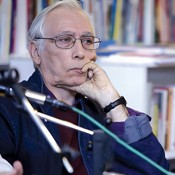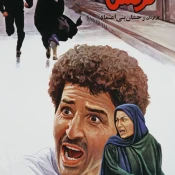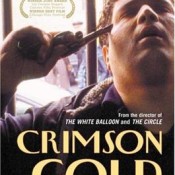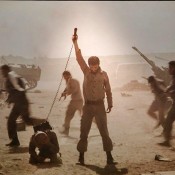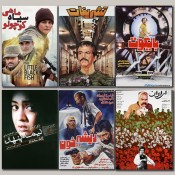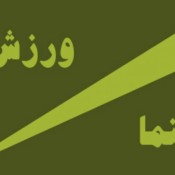A
- Abbas Kiarostami| ‛Abbās Kīyārustamī| عباس کیارستمی
- Abbas Kiarostami’s Documentary Objects; Cinema’s Powers From Rolling Cans to Errant Footballs
- Affective Listening
- Afsānah Bāyigān | Afsaneh Bayegan | افسانه بایگان
- Ali Hatami | ‛Alī Hātamī | علی حاتمی
- Ali Hatami’s Delshodegan (1992)
- Alternative Cinema of Pre-Revolutionary Era
- An Overview of Apartment Dramas in Iranian Cinema After The Green Movement
- Apartment Dramas
- Arbi Hovhannisean | Ārbī Uvānisiyān | آربی آوانسیان
- Art Cinema
- Asghar Farhadi
- Asghar Farhadi and the Dubious Conscience of Post-Revolutionary Iran
- Asghar Farhadi | Asghar Farhādī | اصغر فرهادی
- Aṣghar Farhādī
- A Comparative Study Concerning The First Two Films Directed by Iranian Women
- A Dragon Arrives! (2016)
- A Girl Walks Home Alone at Night
- A Moment of Innocence | Nūn va guldūn | نون و گلدون
- A Party in Hell | Shab’nishīnī dar jahannam | شب نشینی در جهنم
- A Separation | Judāʾī-i Nādir az Sīmīn | جدایی نادر از سیمین
- A Silenced Historical Testimony
- A Simple Event
- A Simple Event (1973)
B
- Bahman Farmanara
- Bahman Farmanara | Bahman Farmānārā | بهمن فرمان آرا
- Bahram Beyzaei | Bahrām Bayzāyī | بهرام بیضائی
- Baizai’s Travelers
- Bashu, The Little Stranger (1986)
- Bashu, the Little Stranger| Bāshū gharībah-yi kūchak | باشو، غریبه کوچک
- Beehive | Kandū | کندو
- Behrouz Vossoughi
- Behrouz Vossoughi and The Failure of Rebelious Masculinity
- Brick and Mirror | Khisht va āyīnah | خشتو آیینه
- Bārān Kawsarī | Baran Kosari | باران کوثری
C
- Certified Copy
- Children of Heaven | Bachchah’hā-yi Āsmān| بچههای آسمان
- Children’s Cinema | Sīnima-yi Kūdak | سینمای کودک
- Children’s Films
- Cinematic Male-Female Relationships
- Cinematic Mise-En-Scène
- Cinema and sports in Iran | سینما و ورزش در ایران
- Cinema Dar Qāb Tambr
- Cinema Rex Fire
- Class Production of Gendered Space: Analysing Iran’s Spacetime Through Abbas Kiarostami’s Early Cinema in 1970s1
- Close-Up (1990)
- Comic Movies
- Connections Between Indian and Iranian Cinema
- Crime Genre in Iranian Cinema
- Crime Thriller Genre
- Crimson Gold | Talā-yi surkh̄ | طلای سرخ
- Cult for Context: The Curious Case of Mārmulak
D
- Dariush Mehrjui | Dāryūsh Mihrjūyī | داریوش مهرجویی
- Death of Yazdgerd | Marg-i Yazdgird | مرگ یزدگرد
- Death of Yazdgird | مرگ یزدگرد
- Documentary Cinema
- Documentary Films
- Documentary Iran in The 1950s: Village Films, Akhbār-i Irān Series, & The Cold War Story of US Government’s Documentary Diplomacy
- Documenting Iran in the 1950s: Village Films
- Domestic Violence in Contemporary Iranian Cinema
- Doubt in Love; Reinterpreting Love in Two Films from Makhmalbaf’s Cinema: The Time of Love – 1991 and Sex & Philosophy – 2005
- Downpour | Ragbār | رگبار
- Drama Movies
- Dukhtar-i Lur (Īrān-i imrūz va Īrān-i dīrūz) | دخترِ لُر (ایران امروز و ایران دیروز)
E
F
- Fakhrī Khurvash | Fakhri Khorvash | فخری خوروش
- Farrokh Ghaffari | Farrukh Ghaffārī | فرخ غفاری
- Farsi Movie | Fīlmfārsī | فیلمفارسی
- Farzānah Ta’īdī | Farzaneh Taidi | فرزانه تاییدی
- Farīmāh Farjāmī | Farimah Farjami | فریماه فرجامی
- Fereydoun Rahnema Between Archaism and Modernism Iran’s Son is Unaware of His Mother
- Fereydoun Rahnema | Farīdūn Rahnamā | فریدون رهنما
- Fereydoun Rahnema’s Postmodernist Approach in Siavash in Persepolis
- Fereydun Gole
- Fereydun Goleh | Farīdūn Gūlah | فریدون گُله
- Filming Locations
- Filming Locations in Iranian Cinema Before The Revolution (1930-1979)
- Film Adaptations and Narrative Change in Persian Fiction
- Film Aesthetics
- Film Criticism
- Film Dubbing
- Film Dubbing Before 1979
- Film Music | Mūsīqī’yah film | موسیقی فیلم
- Film Production at Kanun-i Parvarish-i Fikry
- Film Production at Kanun-i Parvarish-i Fikry (Center for The Intellectual Development of Children and Young Adults)
- Film Schools and Education
- Film-Farsi and Everyday Life: Popular Cinema and Modernity in Pre-Revolutionary Iran
- Forced Empathy and the Geopolitics of Memory in Bahman Ghobadi’s Films
- Forouzan (Parvin Kheirbakhsh) | فروزان (پروین خیربخش)
- From Defense to Intervention: The Iran-Iraq War on Screen and the Evolution of Sacred Defense Cinema
- From Golden City to Felestin: The Onomastics of Cinema Halls in Tehran
- From Karkheh to Rhein| Az Karkhah tā Rāyn | از کرخه تا راین
- From Mehrin Negar to Tara: The Evolution of Female Protagonists in Bahram Beyzaie’s “The Snake King” (1966) and “The Ballad of Tara” (1978-9)
- From Mongols to Television and Cinema (The Mongols / Mogholha- Parviz Kimiavi)
- From The Lor Girl to Bride of Fire: Tribal Women in Iranian Cinema
- From “Golden City” to “Felestin”: The Onomastics of Cinema Halls in Tehran
- Furuzan
- Furūzān Bihrūz | Forouzan Behrouz | فروزان بهروز
- Fātimah Mu‛tamid’āryā | Fatemeh Motamed-Arya | فاطمه معتمدآریا
G
H
- Hadīyah Tihrānī | Hedieh Tehrani | هدیه تهرانی
- Haji Agha, the Cinema Actor | Hājī Āghā Āktur-i Sīnamā | حاجیآقا اکتور سینما
- Hamoun by Dāriūsh Mehrjū’ī
- Hamoun | Hāmūn| هامون
- Hamīdah Khayrābādī | Hamideh Kheirabadi | حمیده خیرآبادی
- Hasan, the Bald | Hasan-Kachal | حسن کچل
- Hauntologies of The Present: Notes on Politics of Friendship in Férydoun Rahnéma’s Modernism
- Hingāmah Ghāzīyānī | Hengameh Ghaziani | هنگامه قاضیانی
- Home in Cinema and Women at Home
- Home in Cinema and Women at Home: A Comparative Study of Pre- and Post-Revolutionary Iranian Cinema from 1969 to 1999
- Horror & Authority in Farrokhzad’s Khānah Siyāh Ast
- Hossein Alizadeh’s Film Scores
- How Frightening Your Makings: Epidemics, Mass Metamorphoses, and Bodies of the Iranian New Wave Cinema
- Humā Rūstā | Homa Rousta | هما روستا
- Hyper-Realism in Digital Films by Abbas Kiarostami
- Hānīyah Tavassulī | Hanieh Tavassoli | هانیه توسلی
I
- Ideology and Social Classes in Iranian Cinema
- Impasse | Tangnā | تنگنا
- Internet Cinema: A Cinema of Embodied Protest
- Iranian Cinema and International Film Festivals: A Crossroads Between Arts and Politics
- Iranian cinema and masculinity | Sinimā-yi Īrān va mardānigī | سینمای ایران و مردانگی
- Iranian Cinema and Women | Sinimā-yi Īrān va zanān | سینمای ایران و زنان
- Iranian Cult Cinema
- Iranian Film Criticism
- Iranian Horror Cinema
- Iranian Women Filmmakers
- Iran’s Cinema in Pursuit of Happiness: Part I (1951-1971)
- Iran’s Son is Unaware of His Mother
- Iran-Iraq War
- Iran’s Cinematic Winter; Under The International Politics
- Irene Zazians | ایرن زازیانس
- I’m Taraneh, 15 | Man Tarānah 15 sāl dāram | من، ترانه 15سال دارم
J
K
L
M
- Mahdi Ivanov (Rusi Khan)
- Mahtāb Karāmatī | Mahtab Keramati | مهتاب کرامتی
- Mahīn Shahābī | Mahin Shahabi | مهین شهابی
- Majid Majidi
- Malakah Ranjbar | Malakeh Ranjbar | ملکه رنجبر
- Male-Female Relationship in Post-Revolutionary Iranian Cinema
- Maryam Amīrjalālī | Maryam Amirjalali | مریم امیرجلالی
- Masoud Kimiai | Mas‛ūd Kīmīyāyī | مسعود کیمیایی
- Mehdi Missaghieh | Mihdī Mīsāqīyyah | مهدی میثاقیه
- Mirīlā Zāri‛ī | Merila Zarei | مریلا زارعی
- Mise En Abym in Iranian Movies
- Mohsen Makhmalbaf
- Mohsen Makhmalbaf | Muhsin Makhmalbāf | محسن مخملباف
- Morteza Hannaneh | Murtizā Hannānah | مرتضی حنانه
- Movie Genres
- Movie Theatres
- Multilinguality in Iranian Cinema
- Mushegh Sarvarian | Mūshiq Sarvarī (Sarvarīyān) | موشق سروری
- Mītrā Hajjār | Mitra Hajjar | میترا حجار
N
- Nargess | Narghis | نرگس
- Naser Malek Motiei | ناصر ملکمطیعی
- Nasir Malek Motiʿi
- Nasser Taghvai
- Nasser Taghvai | Nāsir Taqvāyī | ناصر تقوایی
- Nativism and Utopia in Parviz Kimiavi’s OK Mister
- New Wave Cinema | Sīnamā-yi mawj-i naw̄ | سینمای موج نو
- Night of the Hunchback | Shab-i Qūzī | شب قوزی
- Nigār Javāhirīyān | Negar Javaherian | نگار جواهریان
- Nosratollah Karimi | Nusrat-Allāh Karīmī | نصرت الله کریمی
- Nīkī Karīmī | Niki Karimi | نیکی کریمی
- Nīkū Khiradmand | Nikoo Kheradmand | نیکو خردمند
- Nūrī Kasrā’ī | Nuri Kasrayi | نوری کسرایی
P
- Parviz Kimiavi
- Parviz Kimiavi | Parvīz Kīmiyāvī | پرویز کیمیاوی
- Parviz Sayyad | Parvīz Sayyād| پرویز صیاد
- Parvānah Ma‛sūmī | Parvaneh Massoumi | پروانه معصومی
- Parīnāz Īzadyār | Parinaz Izadyar | پریناز ایزدیار
- PetroCinema in Iran: The Three Waves
- Petrocinema| سینما و صنعت نفت
- Pigāh Āhangarānī | Pegah Ahangarani | پگاه آهنگرانی
- Poetic Pictures: The Feminazation of Iranian Cinema
- Poetic Pictures: The Feminization of Iranian Cinema
- Postmodern Storytelling in Iranian Cinema: Shahram Mokri Films
- Post-Revolutionary Cinema
- Post-Revolutionary Masculinities
- Precarity and Possibility: The Labor of Underground Video Dealers in Iran
- Prince Ehtejab | Shāzdah Ihtijāb |شازده احتجاب
- Pānti’ā Bahrām | Pantea Bahram | پانتهآ بهرام
- Pūrī (Siddīqah) Banāyī | Pouri (Seddigheh) Banayi | پوری بنایی
R
- Rakhshan Banietemad | Rakhshān Banī’iʿtimād | رخشان بنیاعتماد
- Rakhshan Banietemad’s Social Realism
- Ra‛nā Āzādīvar | Rana Azadivar | رعنا آزادیور
- Reform and Its Discontents: Youth and Precarious Life in Postrevolutionary Iran
- Reform Cinema
- Representation of Children and Childhood in Iranian Cinema
- Representation of Urban Ruins in Iranian New Wave Cinema
- Revolutionary cinema | Sīnimā-yi Inqilābī | سینمای انقلابی
- Ruqayyah Chihrah-Āzād | Roghayeh Chehreh-Azad | رقیه چهره آزاد
- Ruyā Taymūrīyān | Roya Teymourian | رویا تیموریان
S
- Sacred Defense Cinema | Sīnamā–yi difāʿ–i muqaddas | سینمای دفاع مقدس
- Sahar Dawlatshāhī | Sahar Dolatshahi | سحر دولتشاهی
- Samira Makhmalbaf | Samīrā Makhmalbāf | سمیرا مخملباف
- Samuel Khachikian | Sāmūʼil Khāchīkiyān | ساموئل خاچیکیان
- Sardar Sager
- Sartorial Islamic Baroque
- Screaming in Silence; Representation of Sexual and Gender Minorities in Post-Islamic Revolution Iranian Cinema
- Self-Reflexive Cinema
- Self-Reflexivity in Iranian New Wave Cinema
- Shahlā Rīyāhī | Shahla Riahi | شهلا رياحي
- Shahscoping Lahore: Elective Affinites in the Era of Regional Cooperation and Development
- Shifting Paradigms: Childhood Constructs in Iranian Children’s Cinema Across Five Decades
- Shirin
- Shirin Neshat’s Land of Dreams: Moving From The Personal to The Universal
- Shirin | شیرین
- Shuhrah Āghdāshlū | Shohreh Aghdashloo | شهره آغداشلو
- Silent Cinema
- Sīnamā-yi Mawj-i Naw
- Sohrab ShahidSales
- Sohrab Shahid-Saless | Suhrāb Shahīd Sālis | سهراب شهید ثالث
- Sound Movies | Sīnamā-yi Nātiq̄ | سینمای ناطق
- South of the City | Junūb-i shahr | جنوب شهر
- Sport in Cinema
- Still Life | Tabī‛at-i bījān | طبیعت بیجان
- Surayā Qāsimī | Soraya Ghasemi | ثریا قاسمی
- Sūsan Taslīmī | Susan Taslimi | سوسن تسلیمی
T
- Tahmineh Milani
- Tahmineh Milani | Tahmīnah Mīlānī | تهمینه میلانی
- Tambourine | Dāyarah-ʼi Zangī | دایره زنگی
- Tangsir | Tangsīr | تنگسیر
- Tarānah ‛Alī-dūstī | Taraneh Alidoosti | ترانه علیدوستی
- Taste of Cherry
- Taste of Cherry | Taʿm-i Gīlās | طعم گیلاس
- Tawqi | Tawqī | طوقی
- Tehran in Iranian Post-Revolutionary Films
- Tehran’s Universal Studios
- The Anthropological Unconscious of Iranian Ethnographic Films: A Brief Take
- The Apple | Sīb | سیب
- The Cinematic and Cultural Legacy of Farrokh Ghaffari
- The Cold War Story of US Government’s Documentary Diplomacy
- The Cow | Gāv | گاو
- The Crow | Kalāgh | کلاغ
- The cycle | Dāyarah-ʼi Mīnā | دایره مینا
- The Death of Sign; A Poetic Cinema of Mohammad Rezā Aslāni
- The Deer | Gavaznhā | گوزنها
- The Fateful Day | Rūz-i vāq‛ah | روز واقعه
- The Heart-Brokens | Sūtah’dilān | سوته دلان
- The Hidden Half | Nīma-yiPinhān | نیمه پنهان
- The House Is Black | Khānah siyāh ast | خانه سیاه است
- The Impact of Cinema on the Socio-Cultural Change in Iran
- The International Reception of Iranian Cinema
- The Introduction and Development of Cinema in Iranian Society and Culture
- The Invincible Six
- The Janitor | Sirāydār | سرایدر
- The Lizard (2004) (Marmulak), Guidance Patrol (2012) (Gasht-e Ershad) and the Semiotic Guerilla Warfare
- The Lost Love
- The Night It Rained | Ūn shab kih bārūn ūmad | اون شب که بارون اومد
- The Runner
- The Runner | Davandeh | دونده
- The Salesman (2016), Gheirat, and Negotiations With The State
- The Soundscape in Diasporic Iranian Cinema
- The Swallows return to the nest | Parastūhā Bi Lāna bār mīgardand | پرستوها به لانه بر می گردند
- The Tenants | Ejāre-nešinhā | اجاره نشینها
- The Use of Invectives in Iranian Cinema: A Case Study of Gender and Social Class in Asghar Farhadi’s Films
- The Wind Will Carry Us | باد ما را خواهد برد
- Through Olive Trees
- Towards A Micropolitics of Homo-eroticism In Shirin Neshat’s Women without Men
- Tracing The Tooba Character in Rakhshan Banietemad’s Cinema
- Travelers (1991)
- Two Women | DuZan | دو زن
U
- Underground: The Secret Life of Videocassettes in Iran
- Under the Skin of the City | Zīr-i pūst-i shahr | زیر پوست شهر
- Unsuccessful Efforts; Historical Assessment of Iranian Animation
- Unveiling Rouhangiz Saminejad: Iran’s Pioneering Actress Forgotten in History
- Using Visual Art to Circumvent Censorship and Enhance the Representation of Women in Iranian Cinema: A Study of ‘Unruled Paper,’ ‘Hamoun,’ and ‘What Time Is It in Your World


